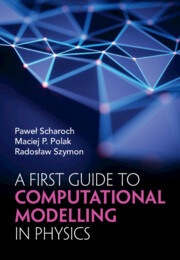Book contents
- Frontmatter
- Contents
- Preface
- How to Use the Book
- First Steps
- Project 1: Rectangular Finite Quantum Well – Stationary Schrödinger Equation in 1D
- Project 2: Diffraction of Light on a Slit
- Project 3: Pendulum as a Standard of the Unit of Time
- Project 4: Planetary System
- Project 5: Gravitation inside a Star
- Project 6: Normal Modes in a Cylindrical Waveguide
- Project 7: Thermal Insulation Properties of a Wall
- Project 8: Cylindrical Capacitor
- Advanced Projects
- Project 9: Coupled Harmonic Oscillators
- Project 10: The Fermi–Pasta–Ulam–Tsingou Problem
- Project 11: Hydrogen Star
- Project 12: Rectangular Quantum Well Filled with Electrons – The Idea of Self-Consistent Calculations
- Project 13: Time Dependent Schrödinger Equation
- Project 14: Poisson’s Equation in 2D
- Appendix A: Supplementary Materials
- Further Reading
- Index
Project 7: - Thermal Insulation Properties of a Wall
Published online by Cambridge University Press: 01 February 2024
- Frontmatter
- Contents
- Preface
- How to Use the Book
- First Steps
- Project 1: Rectangular Finite Quantum Well – Stationary Schrödinger Equation in 1D
- Project 2: Diffraction of Light on a Slit
- Project 3: Pendulum as a Standard of the Unit of Time
- Project 4: Planetary System
- Project 5: Gravitation inside a Star
- Project 6: Normal Modes in a Cylindrical Waveguide
- Project 7: Thermal Insulation Properties of a Wall
- Project 8: Cylindrical Capacitor
- Advanced Projects
- Project 9: Coupled Harmonic Oscillators
- Project 10: The Fermi–Pasta–Ulam–Tsingou Problem
- Project 11: Hydrogen Star
- Project 12: Rectangular Quantum Well Filled with Electrons – The Idea of Self-Consistent Calculations
- Project 13: Time Dependent Schrödinger Equation
- Project 14: Poisson’s Equation in 2D
- Appendix A: Supplementary Materials
- Further Reading
- Index
Summary
This work introduces and explores the thermal insulation properties of a house wall using the partial differential equation method of finite difference (FD). By applying the steady-state diffusion equation, we delve into how the temperature across the wall depends on the thermal conductivity distribution of insulating material. Our study assumes a quasi-1D case where heat diffusion occurs through the wall. We stipulate that the wall interfaces with heat reservoirs on both sides, thereby stabilising the temperature, and that there are no heat sources within the wall itself. We then employ the FD method to transform the boundary value problem for the differential equation into a system of linear equations. An efficient Gaussian elimination with back substitution algorithm is applied to solve this system. This technique simplifies the problem, requiring only two sweeps of arithmetic operations of the order ’N’ to find the solution. The FD method’s limitation – requiring the domain’s shape and the grid to fit the chosen coordinate system – is acknowledged, hinting towards the next chapter’s discussion on finite elements (FE) methods.
Keywords
- Type
- Chapter
- Information
- A First Guide to Computational Modelling in Physics , pp. 45 - 51Publisher: Cambridge University PressPrint publication year: 2024



